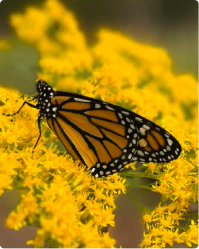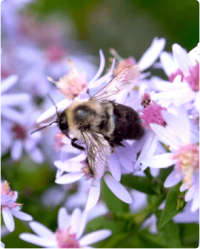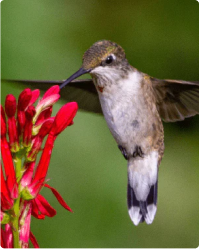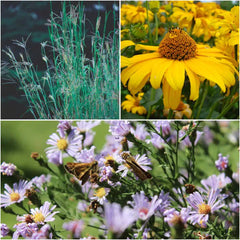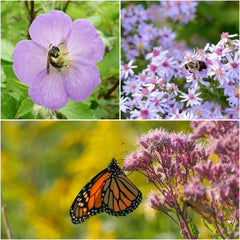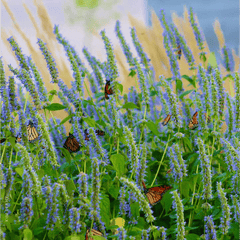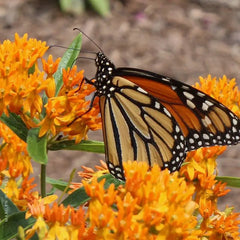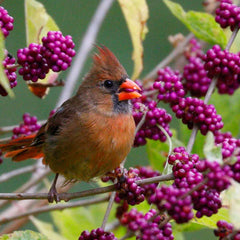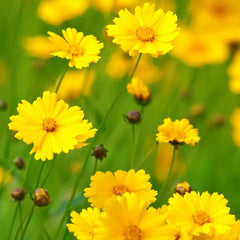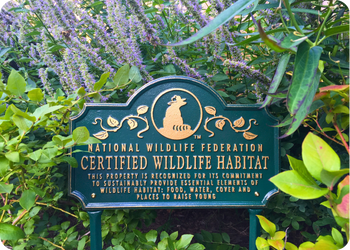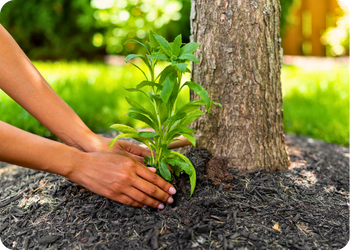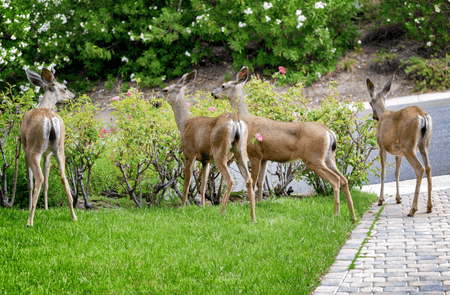Why Garden for Wildlife Supports the Anti-Lawn Movement


Here at Garden for Wildlife, we're supporters of the anti-lawn movement. It's time that we rethink our obsession with manicured green spaces and consider a more sustainable option: native plants provide an ecosystem including water, food, and shelter for native birds, insects, and other kinds of wildlife. Not to mention, native plants require less water and don’t rely on chemicals to look pretty.
“We were excited to report that the number of people planning to transform a portion of their lawn to wildflower native landscape has doubled from 9 percent in 2019 to 19 percent in 2021”, says Mary Phillips, Head of Garden for Wildlife at National Wildlife Federation, “Campaigns like Garden for Wildlife Month in May and more recently, No Mow May, are raising awareness that people can make a difference for wildlife by changing the way they garden and landscape.
Garden for Wildlife and the National Wildlife Federation are generally supportive of any effort that encourages us to manage our yards less intensively, whether that be by reducing water usage, avoiding pesticides, or saying goodbye to a regular mowing schedule.
After all, lawns are essentially just monocultures of grass, and they require a lot of maintenance to stay looking pristine. Caring for lawns releases harmful emissions into the air and uses up valuable resources like water. So why do Americans continue to support this outdated practice?
Why do we have lawns?
There's no denying that lawns are a quintessential part of American culture. For many of us, a lawn is the first thing we think of when we imagine a home. It’s a concept that’s almost become a part of the American Dream — white picket fences and green turf. But have you ever stopped to wonder why lawns are such a big deal in the United States?
One reason for our lawn obsession is that they used to serve as a symbol of leisure and wealth. In the country's early days, only the rich could afford to have lawns. Over time, though (especially once lawnmowers became more affordable), lawns became more commonplace.
Another reason for our love of lawns is that they provide a sense of order and control. It can be soothing to come home to a neat and tidy yard in a fast-paced world. The problem is that lawns aren’t doing us (or the wildlife) any favors.
The downside of residential lawns
What many people don't realize is that other than aesthetics, lawns don’t provide any benefit to us or wildlife. Here are just a few of the ways that lawns can be harmful to the environment:
- They require a lot of water. Every year, residential lawns consume trillions of gallons of water. This water could be used for more environmentally-friendly purposes, such as watering an agricultural crop.
- They need chemicals. To keep lawns green and free of weeds, homeowners and lawn industry companies use large quantities of fertilizers and pesticides. These chemicals can harm the environment — and the people or animals who come into contact with them.
- They don't provide much habitat for wildlife. Most lawns are turf grass, providing very little food or shelter for wildlife and can negatively impact local ecosystems.
As you can see, there are some serious downsides to lawns.
What is the anti-lawn movement?
Over the last few decades, there has been a growing movement of people choosing to forgo the traditional lawn in favor of a more natural landscape. This trend is often referred to as the "anti-lawn movement." Those who embrace this philosophy believe that lawns waste time and resources. They argue that mowing lawns emits harmful greenhouse gasses, uses valuable water resources, and creates mountains of yard waste.
And they’re right.
The anti-lawn movement is a new way of thinking about lawn care. Instead of mowing lawns, the goal is to let them grow wild. This includes letting grasses and other native plants grow to their natural height and using herbicides and pesticides sparingly, if at all.
The aim is to create a more sustainable, natural environment and to help make beautiful yards that are healthy for both people and wildlife. As the anti-lawn movement grows, more and more people are rethinking their relationship with their yards.
The rise of the anti-lawn meme
In recent years, people have been saying "enough is enough" to the never-ending cycle of mowing a large lawn. These so-called "anti-lawners" have taken to social media to share their disdain for lawn mowing, and they're quickly gaining traction.

Across multiple social media platforms, a movement of environmental activists and younger, eco-aware users is raising awareness of the many environmental issues caused by the classic “green carpet” lawn. On TikTok alone, videos tagged with #nolawns have over 6 million views. The anti-lawn memes are here to stay, and that online concern reflects a growing offline awareness of how grass lawns hurt the environment.
And on Twitter, it’s clear that grassy green patches represent a missed opportunity, negatively impact climate change action, and that native species of grasses and other plants are the preferred choice. The memes are bringing the argument to a whole new generation — one that’s very aware of the threat of our continued totalitarian approach to nature.
There are even entire subreddits based on the movement, with the most popular being r/nolawns.
Real change is happening
The anti-lawn movement challenges us to rethink our relationship with lawns. They argue that we don't need to mow our lawns every week to have a beautiful yard, and there are plenty of alternatives to traditional turf grass that require far less maintenance. So if you're tired of mowing your lawn every week, start thinking about switching to a no-mow lawn. It might be the best decision you ever make for your front yard — and the planet.
The anti-lawn movement is growing loud enough to cause real change. Check out some states that have started taking the initiative when it comes to lawns:
- In California and Utah, residents can take advantage of buyback programs, where they can get up to $2,000 if they switch from green turf to less water-consuming landscapes.
- The water department for Los Angeles now offers residential customers up to $15,000 worth of rebates if those residents plant native plants rather than grass turf. They also offer free online classes about yard transformation!
- Even smaller towns, like Maryland’s College Park, are making changes. The town has recently completely rewritten its city codes and actively encourages residents to create more “naturalized and native landscapes.”
- In Nevada, a new law has been passed that bans non-essential turf throughout the entire Las Vegas region.
- And Montgomery County in Maryland has a scheme where residents can get paid to have more water-aware gardens.
The fight against monocultures
A healthy lawn may seem like foundation of a well-landscaped rear or front yard. It provides a clean, green space for families to enjoy picnics, kids to play ball, and pets to run around. But lawns are monocultures — a single species of plant that dominates the landscape.
This lack of diversity harms local ecosystems because native plants and animals have evolved together over millennia and depend on each other for food and shelter.
Native wildlife species generally need a diverse plant palette, and unfortunately lawns often represent a homogenous, open area of poor-quality habitat for many wildlife species. This is especially true for native pollinators like bees. In many cases, lawns are made up of non-native grass species which can restrict yard habitat quality even further.
In the end, grass-free lawns containing native plants are the most optimal for wildlife—especially for insects and the birds that feed upon them. We recommend removing turf where possible and planting a variety of low-growing native groundcover and grasses to offer wildlife a refuge of well-balanced habitat.
The whole system is disrupted when one piece of the puzzle is removed. The anti-lawn movement is gaining momentum as people become more aware of the negative impacts of these ubiquitous grassy spaces.
The idea of planting more pollinator-friendly native plants was even a trend at 2022’s Chelsea Flower Show. Landscape architects are looking at traditional lawns as the outdated concept they truly are. For example, Tilly, the personalized online landscape design service that creates custom plans for homeowners nationwide, and the National Wildlife Federation have teamed up. To help homeowners across the country easily design sustainable landscape plans for their yards. We love to see businesses helping homeowners switch to more sustainable options!
You can make a difference by planting native grasses or trees, which provide a habitat for wildlife and require less maintenance than traditional lawns. So let's celebrate biodiversity – not just in our yards, but in our communities and worldwide.
Local ordinances and homeowner associations
For years, the anti-lawn movement has been slowly gaining ground across America. As awareness of the environmental impacts of turf grass grows, more and more people are beginning to question the need for a perfectly manicured lawn.
Homeowner associations and local ordinances often dictate the minimum length of grass that must be maintained, often under the guise of concerns like fire and pest control. However, many of these concerns are simply aesthetic.
Open discussion with officials
Homeownership is a tremendous opportunity to stabilize communities, cultivate a sense of pride, and build equity. But for too long, the American dream of home ownership has included lawns.
Normalizing the no-mow lawn would create much more valuable green space in our outdoor spaces. One way to push for this opportunity is to engage your local officials. Talk to your city council and health department about the benefits of no-mow lawn movements, and see if they would be willing to support your efforts.
You could also work with local businesses to promote no-mow lawns as an environmentally friendly alternative to traditional lawns. Getting the community on board can help make no-mow lawns the new normal.
Educate your neighbors
You should also consider educating your neighbors about the benefits of no-mow lawns. Explaining that they provide ground cover year-round, help conserve water, and provide habitat for pollinators and other beneficial insects can go a long way toward convincing people to give them a try.
Another strategy is to get your yard certified as a National Wildlife Federation Certified Wildlife Habitat and install signs to encourage your neighbors.
Finally, remember to keep your no-mow lawn looking tidy. A well-maintained no-mow lawn will be more likely to convince others to give it a try.
Swap turf for native plants

In contrast, a habitat garden is teeming with life — from the soil microorganisms to the bees and butterflies pollinating the plants. A habitat garden can be designed to fit any space, they don't require special equipment or knowledge, and planting native plants is incredibly easy.
We do recognize that completely removing turf is not always an inexpensive or otherwise valid option. In these cases, reducing mowing can be helpful for improving conditions for local wildlife. In Massachusetts, for example, lawns mowed every three weeks supported 2.5 times more lawn flowers than lawns mowed every week, providing a huge increase in the number of flowers available for pollinator use. Indeed, allowing these flowers to grow by only partially mowing or delaying mowing until late-summer increases the number of butterfly and bee species in the area.
Lawns with tall grass can be beneficial for other wildlife, too. Excluding seabirds, 96% of all North American bird species feed insects to their young, meaning many birds can benefit from the high densities of insects long-grass lawns support. Generally, the more natural cover a yard boasts, the better habitat it provides for foraging birds. Tall grass also creates shelter for many other small species of wildlife, including frogs, snakes, and mice. Healthy populations of these small critters in turn supports larger urban predators such as owls, hawks, and raccoons.
Garden for Wildlife and the National Wildlife Federation encourages wildlife-minded homeowners to manage their yards in ways that best benefit our native creatures. Ideally, this means entirely replacing grass lawns with native plant material. If this is not a possibility, participation in No Mow May remains a smaller, but achievable means of contributing to local wildlife health. Learn how you can certify your own backyard as wildlife habitat here.
Whether you have a small balcony or a large yard, you can make a difference for local wildlife by ditching your lawn and creating a habitat garden with the right native plants for the right place.
Not sure what the right plants are for your garden? Try our native plant finder by ZIP code! Sport your support of wildlife and native plants with Garden for Wildlife themed shirts, tote bags, water bottles, stickers, and more. Check out our merch shop now.
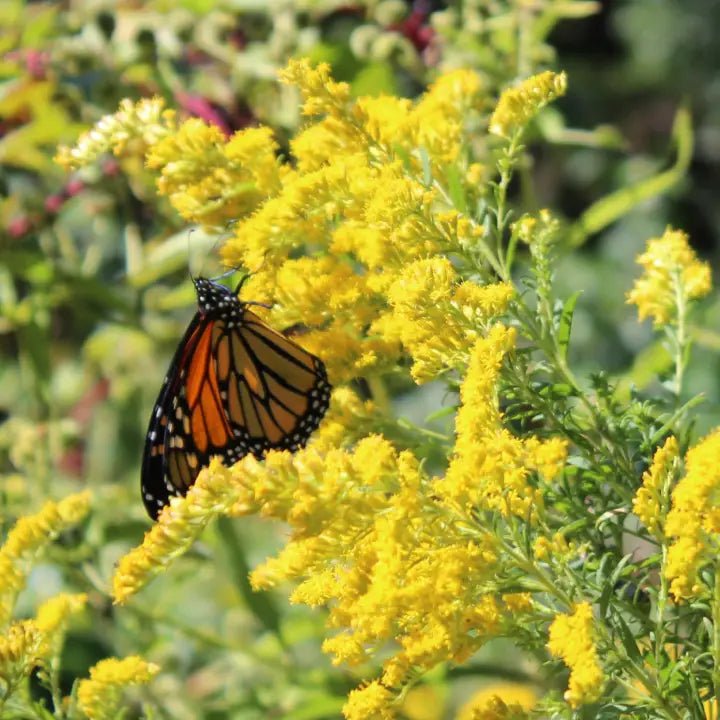
Find Native Plants by Zip Code
We took the guesswork out of planting native. Check your zip to see what ships!
